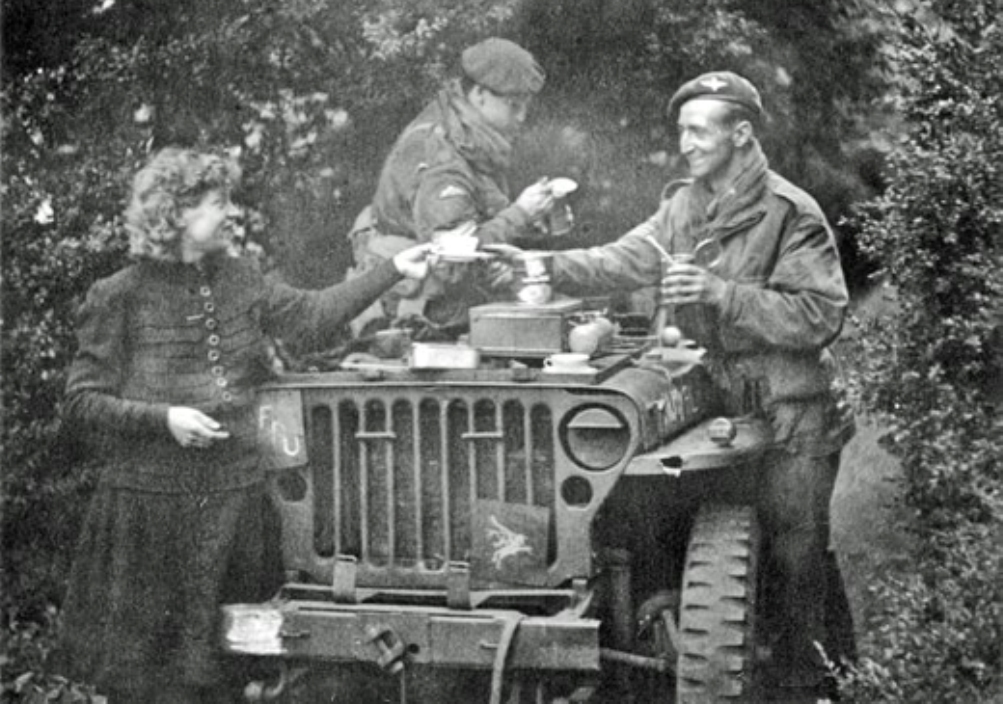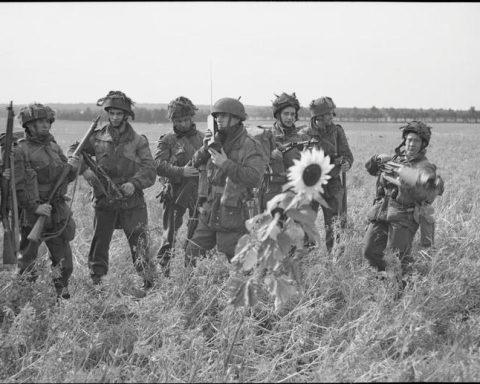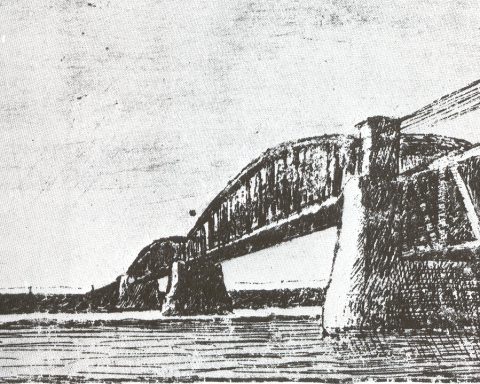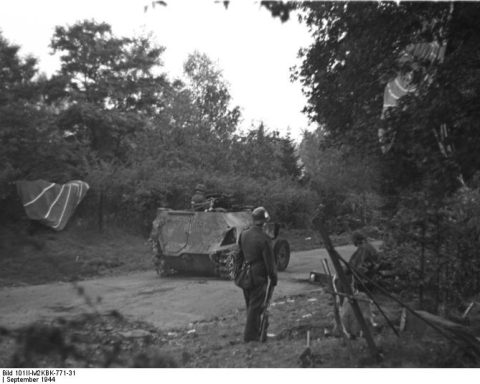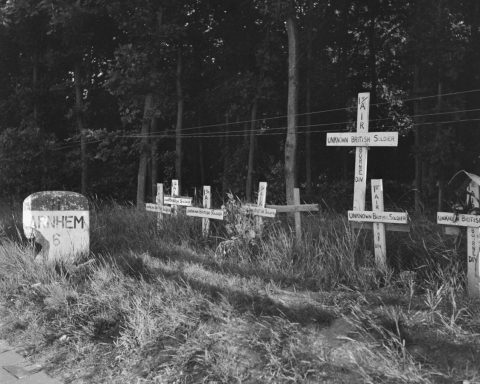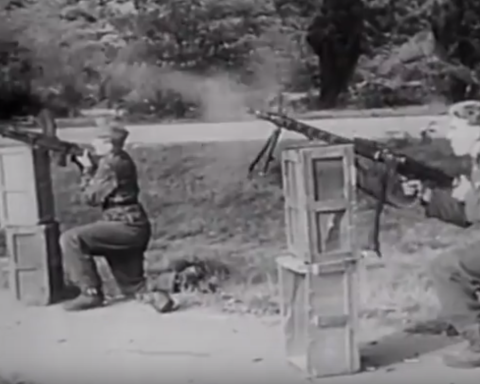On the first day of Market Garden, three British paratrooper battalions advanced from the landing areas at Wolfheze to Arnhem. The third battalion under Colonel John Fitch had been ordered to take the road to Arnhem via the Utrechtseweg. The majority of the battalion did not get further than the Hartenstein hotel in Oosterbeek on the first day.
The battalion was part of General Lathbury’s First Parachute Brigade. The objective of the third battalion was to advance via the Utrechtseweg to the road bridge near Arnhem to form the main force there, north of the Rhine bridge.
In addition to the battalion’s infantry itself, the battalion was reinforced with half a platoon of Royal Engineers, a few Dutch commandos and three six-pounder anti-tank guns. All told, the third battalion consisted of a column of more than a mile.
The troop of soldiers made steady progress during the first hours. Although there was actually no German resistance in the first hours, the advance towards Arnhem progressed slowly. There was no organized German resistance in the first hours after the landing. If there were any losses, it was due to uncoordinated German attempts to stop the advance.
The first major firefight took place just after five o’clock in the afternoon at the intersection between Utrechtseweg and Wolfhezerweg near Wolfheze. A German staff car suddenly appeared between the leading column of English paratroopers.
In the staff car was German General Friedrich Kussin, the German city commander, who wanted to be informed about the airborne landings.
After the war, British lieutenant Cleminson gave an account of what happened:
“The leading men of my vanguard immediately opened fire with sten guns and rifles. The side of the car was completely punctured. It was over in a flash.”
The German general was killed in the firefight together with an interpreter, his driver and an attendant.
Armored car
Cleminson’s platoon tried to advance further, but came under fire from a German armored car within a few hundred meters. The armored car was part of the first serious defense line that the Germans had set up.
German Major Sepp Krafft had his headquarters in Wolfheze and led a battalion of SS troops. Krafft immediately realized after the airborne landings that the Rhine Bridge in Arnhem was the likely target of the British airborne landings. He placed his troops east of Wolfheze in a defensive line between the railway and the Utrechtseweg.
The armored car, probably a self-propelled anti-aircraft gun, took out several British soldiers. They sought refuge in the houses and gardens in the area.
Lieutenant Cleminson: “We had nothing to attack this armored vehicle with. I had ducked into a house and got to my feet. I was behind the armored vehicle. I shot a German down in the garden with my sten and wondered what we could do to get rid of the armored visitor.”
A British soldier fired a flare at the armored vehicle. That had no effect, but did cause the armored vehicle to drive away in reverse.
Cleminson: “The men of my platoon quickly realized that it was not the right way to advance to the bridge: along a main road, without anti-tank weapons against armored opponents.”
Although the action had lasted no longer than ten minutes, there had been sufficient casualties. There were some deaths, several injuries and prisoners.
Delay
Due to increased German resistance and the unexpected presence of German armored cars, Colonel Fitch realized that he had to do something about the slow advance. Fitch had already been told by General Lathbury that he was not making enough speed.
Fitch sent part of his troops, C-Company, to Arnhem via a slightly northern route. The company was sent to Arnhem via the Bredelaan. There that evening they reached Colonel Frost’s troops who had just occupied the north side of the Rhine Bridge: a remarkable achievement.
The delay of the rest of the third battalion only increased that evening. This had, among other things, to do with German resistance in the woods near the Bilderberg hotel west of Oosterbeek. German machine guns and mortars caused British casualties there.
General Lathbury, who marched with the 3rd Battalion, ordered Lieutenant Tony Baxter to comb the woods near the Bilderberg Hotel.
“We fanned out and went into the woods. I shot a German I could see with a rifle. I looked through the sight and held my left thumb over the barrel. The German I was aiming at was about 40 meters away. But he shot first. The bullet hit my thumb on the barrel. The bone broke and my thumb hung off.”
Although the British shot a number of Germans, they were unable to clear the entire forest of Germans. This became apparent when the British briefly consulted at the edge of the forest. The Germans immediately fired a number of mortars at the assembled British soldiers, killing three sergeants.
Eighteen British people were killed in the fighting in the woods west of Oosterbeek. It was the last attempt by Sepp Krafft’s battalion to stop the British. Because he was afraid that he would become trapped, he withdrew further towards Arnhem.
Due to Krafft’s presence, the British did not dare to advance during the evening. It had gotten dark around 9:30 PM and the British paratroopers did not know the extent of the resistance they faced.
For that reason we stopped at an old, stately hotel. Until that afternoon, ‘Hartenstein’ in Oosterbeek had been used by the headquarters of Field Marshal Walter Model’s German Heeresgruppe B. Now it was taken by the British.
Not everyone understood Lathbury and Fitch’s decision to stop for a few hours near Hartenstein.
Major Bush later said: “That was the start of the trouble. If Generals Urquhart and Lathbury had not been with us, Colonel Fitch would probably have advanced along the Bredeweg, just like C-Company. But he could hardly move without permission from the division commander and the brigade commander. It was a hopeless situation.”
Until 4:30 am almost all troops of the third battalion halted. That seven-hour break gave the Germans, who did not sit still, the opportunity to set up a solid defense near the Elisabeth Gasthuis on the west side of Arnhem.
The third battalion would not go further than that in the coming days.

